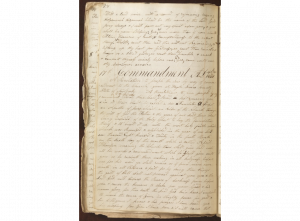Historical Context and Background of D&C 21

Video Overview
Brief Synopsis by Steven C. Harper
After more than a year of anticipation, Joseph Smith and Oliver Cowdery organized the Church of Jesus Christ on April 6, 1830, as the Lord commanded. At the organizational sacrament meeting, Joseph received section 21. In this revelation the Lord established the order of his Church. Elder Boyd K. Packer taught the relationship between order, ordaining, and ordinances. To ordain, he said, was the process of putting things in order. He defined an ordinance as a ceremony by which things are put in order.1 Consider section 21 in that light.
The order the Lord intends is clear from what the revelation says and how it says it. Jesus reveals it to Joseph, who reveals it to the Saints. The Lord authorizes Oliver to ordain Joseph as the first or presiding elder, “this being an ordinance unto you” (D&C 21:10–11). Oliver is to be ordained as the second elder, again by an ordinance. The Savior leads his Church. Joseph speaks on his behalf. The Savior inspires Joseph to move the cause of Zion forward. The Saints sustain Joseph and Oliver as their leaders and give heed to their words as they heed the Savior’s. This ordained order requires “patience and faith” (D&C 21:5).
The first command in the revelation is to record these things. The acts of putting the Lord’s Church in its ordained order must be documented. Section 21 restored the Church of Jesus Christ. After nearly two millennia, duly authorized apostles were ordained and assigned by Jesus Christ to lead his church. Many people have “wished,” as one wrote, “I had lived in the days of the prophets or apostles, that I could have sure guides.” Others looked forward, waiting for the Lord to send new apostles.2 Those hopes were realized on April 6, 1830. As Joseph put it, “The Church of Jesus Christ of Latter-day Saints was founded upon direct revelation, as the true church of God has ever been, according to the scriptures.”3
1. Boyd K. Packer, “Ordinances,” BYU Devotional, February 3, 1980.
2. Nathan O. Hatch, The Democratization of American Christianity (New Haven: Yale University Press, 1989), 17. Jeffrey R. Holland, “Prophets, Seers, and Revelators,” Ensign(November 2004): 6.
3. “‘Latter Day Saints,’ 1844,” p. 404, The Joseph Smith Papers, accessed July 23, 2020.
Additional Context by Casey Paul Griffiths
From Doctrine and Covenants Minute
This revelation in Doctrine and Covenants 21 was given in the home of Peter Whitmer Sr. in Fayette, New York, shortly after the meeting in which the Church was formally organized. Joseph Smith described the meeting as follows: “Having opened the meeting by solemn prayer to our Heavenly Father we proceeded, (according to previous commandment) to call on our brethren to know whether they accepted us as their teachers in the things of the Kingdom of God, and whether they were satisfied that we should proceed and be organized as a Church according to said commandment which we had received. To these they consented by a unanimous vote. I then laid my hands upon Oliver Cowdery and ordained him an Elder of the ‘Church of Jesus Christ of Latter Day Saints,’ after which he ordained me also to the office of an Elder of said Church” (JS History, vol. A-1, 37, JSP). This entry in Joseph Smith’s history was written after the official name of the Church was given in revelation in 1838 (D&C 115:4), and Joseph retroactively uses the official name in his history.
Further describing the meeting, the Prophet recorded, “We then took bread, blessed it, and brake it with them, also wine, blessed it, and drank it with them. We then laid our hands on each individual member of the Church present that they might receive the gift of the Holy Ghost, and be confirmed members of the Church of Christ. The Holy Ghost was poured out upon us to a very great degree. Some prophesied, whilst we all praised the Lord and rejoiced exceedingly. Whilst yet together I received the following commandment [Doctrine and Covenants 21]” (JS History, vol. A-1, p. 37, JSP).
See Historical Introduction, “Revelation, 6 April 1830 [D&C 21],” p. 28, The Joseph Smith Papers, accessed October 27, 2020, https://www.josephsmithpapers.org/paper-summary/revelation-6-april-1830-dc-21/1
